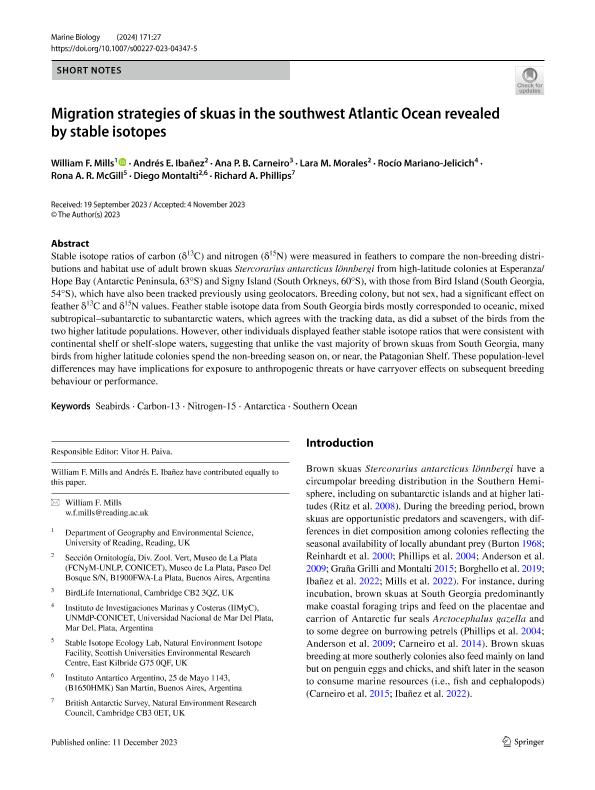Artículo
Migration strategies of skuas in the southwest Atlantic Ocean revealed by stable isotopes
Mills, William F.; Ibañez, Andres Esteban ; Carneiro, Ana P. B.; Morales, Lara Mariel
; Carneiro, Ana P. B.; Morales, Lara Mariel ; Mariano y Jelicich, Rocío
; Mariano y Jelicich, Rocío ; McGill, Rona A. R.; Montalti, Diego
; McGill, Rona A. R.; Montalti, Diego ; Phillips, Richard A.
; Phillips, Richard A.
 ; Carneiro, Ana P. B.; Morales, Lara Mariel
; Carneiro, Ana P. B.; Morales, Lara Mariel ; Mariano y Jelicich, Rocío
; Mariano y Jelicich, Rocío ; McGill, Rona A. R.; Montalti, Diego
; McGill, Rona A. R.; Montalti, Diego ; Phillips, Richard A.
; Phillips, Richard A.
Fecha de publicación:
12/2023
Editorial:
Springer
Revista:
Marine Biology
ISSN:
0025-3162
Idioma:
Inglés
Tipo de recurso:
Artículo publicado
Clasificación temática:
Resumen
Stable isotope ratios of carbon (δ13C) and nitrogen (δ15N) were measured in feathers to compare the non-breeding distributions and habitat use of adult brown skuas Stercorarius antarcticus lönnbergi from high-latitude colonies at Esperanza/Hope Bay (Antarctic Peninsula, 63°S) and Signy Island (South Orkneys, 60°S), with those from Bird Island (South Georgia, 54°S), which have also been tracked previously using geolocators. Breeding colony, but not sex, had a significant effect on feather δ13C and δ15N values. Feather stable isotope data from South Georgia birds mostly corresponded to oceanic, mixed subtropical–subantarctic to subantarctic waters, which agrees with the tracking data, as did a subset of the birds from the two higher latitude populations. However, other individuals displayed feather stable isotope ratios that were consistent with continental shelf or shelf-slope waters, suggesting that unlike the vast majority of brown skuas from South Georgia, many birds from higher latitude colonies spend the non-breeding season on, or near, the Patagonian Shelf. These population-level differences may have implications for exposure to anthropogenic threats or have carryover effects on subsequent breeding behaviour or performance.
Palabras clave:
ANTARCTICA
,
CARBON-13
,
NITROGEN-15
,
SEABIRDS
,
SOUTHERN OCEAN
Archivos asociados
Licencia
Identificadores
Colecciones
Articulos(CCT - LA PLATA)
Articulos de CTRO.CIENTIFICO TECNOL.CONICET - LA PLATA
Articulos de CTRO.CIENTIFICO TECNOL.CONICET - LA PLATA
Articulos(IIMYC)
Articulos de INSTITUTO DE INVESTIGACIONES MARINAS Y COSTERAS
Articulos de INSTITUTO DE INVESTIGACIONES MARINAS Y COSTERAS
Citación
Mills, William F.; Ibañez, Andres Esteban; Carneiro, Ana P. B.; Morales, Lara Mariel; Mariano y Jelicich, Rocío; et al.; Migration strategies of skuas in the southwest Atlantic Ocean revealed by stable isotopes; Springer; Marine Biology; 171; 1; 12-2023; 1-6
Compartir
Altmétricas



